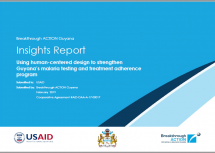Using Human-centered Design to Strengthen Guyana’s Malaria Testing and Treatment Adherence Program
This is a report on qualitative research undertaken by Breakthrough ACTION Guyana, USAID’s flagship social and behavior change (SBC) project designed to improve malaria outcomes among priority populations. The project uses innovative SBC approaches to address key behaviors related to malaria testing and treatment.
In Guyana, malaria is an issue in many regions, particularly among gold-mining populations. In response, the Ministry of Public Health (MoPH), the Pan American Health Organization, and the Global Fund to Fight AIDS, Tuberculosis and Malaria have introduced malaria rapid diagnostic tests (RDTs) to provide services in hard to reach areas. To support this initiative, Breakthrough ACTION is collaborating with the MoPH to respond to the following motivating question: How might we improve malaria outcomes in these regions?
Guided by Breakthrough ACTION’s SBC Flowchart, two teams of researchers from the MoPH Vector Control Services and Public Relations/Health Promotion Unit along with Breakthrough ACTION staff conducted qualitative research in two regions. These research teams interviewed miners, camp managers, trained malaria testers, community health workers, pharmacists, regional administrative officers, and other vital stakeholders to understand the nature of current malaria services, behaviors around malaria testing, use of recommended and alternative treatments, and the broader malaria context that miners work in.
A total of 108 participants were interviewed. Based on these interviews, the research teams identified key findings and quotes and clustered them into sub-themes. Together, both teams identified larger themes and organized the sub-themes accordingly. Eleven insights were developed. In addition to these insights, audience segments, personas, and journey maps were created to summarize stakeholders interviewed and experiences shared. Breakthrough ACTION will use these insights to develop salient solutions and prototypes to encourage greater use of malaria testing services and recommended treatment regimens.
Source: Johns Hopkins Center for Communication Programs
Date of Publication: July 12, 2019
SIMILIAR RESOURCES
Tools
Examples
- Human-Centered Design Templates and Tools
- Design Kit: The Facilitator’s Guide to Teaching Human-Centered Design
- Design Kit for Human-Centered Design
- What is Human-Centered Design?
- ITN Access and Use Report
- Course on Human-Centered Design
- Principles of Human-Centered Design
- ITN Access and Use Report 2018
- SBCC for Malaria in Pregnancy: Strategy Development Guidance
- Understanding ITN Use: What do your Numbers Really Mean? - Webinar and Presentation
- Using Human-Centered Design to Improve Malaria Outcomes in Regions 7 and 8
- Malaria-themed Radio Magazine Program
- Nigeria Advocacy, Communication and Social Mobilization Guide
- Innovation Brief: Applying the Human-Centered Design Approach
- Attitudes, Beliefs and Practices Relevant to Malaria Prevention and Treatment in Liberia

